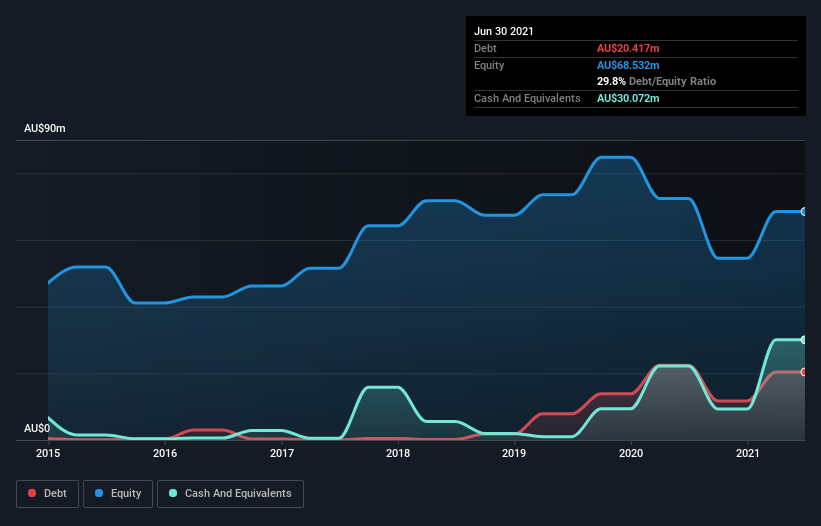Health Check: How Prudently Does Clean Seas Seafood (ASX:CSS) Use Debt?
Some say volatility, rather than debt, is the best way to think about risk as an investor, but Warren Buffett famously said that 'Volatility is far from synonymous with risk.' So it seems the smart money knows that debt - which is usually involved in bankruptcies - is a very important factor, when you assess how risky a company is. Importantly, Clean Seas Seafood Limited (ASX:CSS) does carry debt. But is this debt a concern to shareholders?
What Risk Does Debt Bring?
Debt is a tool to help businesses grow, but if a business is incapable of paying off its lenders, then it exists at their mercy. In the worst case scenario, a company can go bankrupt if it cannot pay its creditors. However, a more common (but still painful) scenario is that it has to raise new equity capital at a low price, thus permanently diluting shareholders. Having said that, the most common situation is where a company manages its debt reasonably well - and to its own advantage. The first step when considering a company's debt levels is to consider its cash and debt together.
See our latest analysis for Clean Seas Seafood
How Much Debt Does Clean Seas Seafood Carry?
You can click the graphic below for the historical numbers, but it shows that Clean Seas Seafood had AU$20.4m of debt in June 2021, down from AU$22.4m, one year before. But it also has AU$30.1m in cash to offset that, meaning it has AU$9.66m net cash.

How Strong Is Clean Seas Seafood's Balance Sheet?
Zooming in on the latest balance sheet data, we can see that Clean Seas Seafood had liabilities of AU$22.2m due within 12 months and liabilities of AU$11.3m due beyond that. Offsetting these obligations, it had cash of AU$30.1m as well as receivables valued at AU$6.38m due within 12 months. So it can boast AU$2.99m more liquid assets than total liabilities.
This short term liquidity is a sign that Clean Seas Seafood could probably pay off its debt with ease, as its balance sheet is far from stretched. Simply put, the fact that Clean Seas Seafood has more cash than debt is arguably a good indication that it can manage its debt safely. The balance sheet is clearly the area to focus on when you are analysing debt. But ultimately the future profitability of the business will decide if Clean Seas Seafood can strengthen its balance sheet over time. So if you're focused on the future you can check out this free report showing analyst profit forecasts.
In the last year Clean Seas Seafood wasn't profitable at an EBIT level, but managed to grow its revenue by 20%, to AU$48m. With any luck the company will be able to grow its way to profitability.
So How Risky Is Clean Seas Seafood?
By their very nature companies that are losing money are more risky than those with a long history of profitability. And the fact is that over the last twelve months Clean Seas Seafood lost money at the earnings before interest and tax (EBIT) line. And over the same period it saw negative free cash outflow of AU$13m and booked a AU$32m accounting loss. Given it only has net cash of AU$9.66m, the company may need to raise more capital if it doesn't reach break-even soon. With very solid revenue growth in the last year, Clean Seas Seafood may be on a path to profitability. Pre-profit companies are often risky, but they can also offer great rewards. The balance sheet is clearly the area to focus on when you are analysing debt. However, not all investment risk resides within the balance sheet - far from it. Case in point: We've spotted 2 warning signs for Clean Seas Seafood you should be aware of.
Of course, if you're the type of investor who prefers buying stocks without the burden of debt, then don't hesitate to discover our exclusive list of net cash growth stocks, today.
New: AI Stock Screener & Alerts
Our new AI Stock Screener scans the market every day to uncover opportunities.
• Dividend Powerhouses (3%+ Yield)
• Undervalued Small Caps with Insider Buying
• High growth Tech and AI Companies
Or build your own from over 50 metrics.
This article by Simply Wall St is general in nature. We provide commentary based on historical data and analyst forecasts only using an unbiased methodology and our articles are not intended to be financial advice. It does not constitute a recommendation to buy or sell any stock, and does not take account of your objectives, or your financial situation. We aim to bring you long-term focused analysis driven by fundamental data. Note that our analysis may not factor in the latest price-sensitive company announcements or qualitative material. Simply Wall St has no position in any stocks mentioned.
Have feedback on this article? Concerned about the content? Get in touch with us directly. Alternatively, email editorial-team (at) simplywallst.com.
About ASX:CSS
Clean Seas Seafood
Operates in the aquaculture industry in Australia, Europe, North America, Asia, and internationally.
Mediocre balance sheet low.
Similar Companies
Market Insights
Community Narratives




